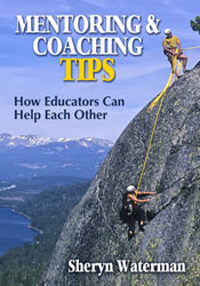Mentoring Across the Hall
Mentoring and Coaching Tips: How Educators Can Help Each Other
By Sheryn Waterman
(Eye on Education/Routledge, Inc. 2013 Learn more)
When I began to host student teachers in my classroom many years ago, I attended a training session to learn how to be a good mentor teacher. One of the trainers made an observation that has always stayed with me. She said that teaching was one of the only professions in which a brand new, first year teacher has all of the same rights and responsibilities as a 30-year veteran.
That comment struck me because, while new teachers do have all of the same rights and responsibilities, they usually do not have the experience to know how to deal with many everyday situations, which can quickly become overwhelming. Often, they are not sure who to turn to in order to get that help. That’s where a book like this one, Mentoring and Coaching Tips : How Educators Can Help Each Other, can be a lifesaver.
 Building Trust
Building Trust
The relationship between veteran teachers and younger teachers can be one of a school’s strongest assets, if that relationship is nurtured intentionally. This book provides a guide to do just that. It is filled with practical, ready-to-use advice, ranging from activities that would build trust and communication between two teachers as well as some that would translate well to a school-wide faculty inservice team-building time.
The author is quick to stress Mentoring & Coaching Tips is not a one-size-fits-all solution. She encourages the reader to pay attention to the culture of an individual school; she’s not offering a packaged program in a book. But based on my experience, it is a helpful road map for creating strong, trusting bonds between teachers.
Challenges to Meet
In many ways, teaching is a very solitary and individual process. Once student teachers graduate, are certified and begin teaching in their own classrooms, they often stop seeing models of good teaching in action. Even talented young teachers sometimes feel as though they are on their own in a sink-or-swim situation. New teachers need someone in whom they can trust and confide, someone wise enough to listen and to help them find perspective.
For any teachers who struggle (which, honestly, could be any teacher on any given day), it’s easy to give in to self-doubt. Teaching can sometimes feel like trying to assemble a 1000-piece puzzle only to discover that the box top with the picture guide is missing. Without that guide, it’s easy to lose your way.
Many teachers don’t feel safe asking for help because they think they should have all of the answers. This book opens the door to very necessary conversations (like a conversation about how nobody has all of the answers!) and it offers suggestions to build trust among colleagues in a coaching relationship.
Guides for Getting Started
The author also notes some potential pitfalls (and offers remedies for them) while implementing this process:
• A teacher + a coach should be carefully and thoughtfully matched; this must be an intentional process, not a haphazard slapping together of names. The process of building trust can be differentiated for adults as we differentiate our instruction for our students – meeting individual needs while working toward the same goal.
• Teachers face many restrictions, such as confidentiality, the pressure of standardized testing, muddied roles with colleagues. These issues must be addressed and dealt with when matching people in a coaching relationship, otherwise things can get sticky.
• Time must be given, above and beyond the teaching day, for coaching to take place. Teachers are already stretched quite thin and adding one more thing to an already full day can be counter-productive; instead of both parties feeling energized by the relationship, they can become frazzled and see coaching as one more thing to check off the never-ending to-do list.
• Veteran teachers shouldn’t assume that they have all of the answers, or that what works for them in their own classrooms will work for everyone.
• Strong coaches practice reflective listening and share options, not decrees, with their colleagues.
• Administrators can be crucial to the success of a coaching culture in their schools. They can model this at faculty meetings, provide time for conflict resolution, be available to assist as the relationship develops and know when to step back as the relationship flourishes.
• Jealousies may arise if non-coaching teachers interpret coaches as having special privileges or as being an extension of the administration. This is another area where the administration plays a crucial role. By creating a culture of coaching in the school, all teachers realize that they play a part in each others’ successes. This tone must be set from the top and flow down.
• Those involved in coaching must create time for regular, thoughtful interactions with each other, whether over email or in face-to-face meetings. It’s important to nurture this connection with frequent communication, however brief.
• As a coach, actions speak louder than words. Saying that you have an open door policy but appearing frustrated or complaining about interruptions when others ask for help will send mixed messages.
• Don’t assume that all new teachers need the same amount of help or that all veteran teachers will be strong coaches. One size definitely does not fit all.
As teachers, we are in the business of helping others to grow and learn and become increasingly independent. This shouldn’t be limited just to our students. Teachers can have the same impact on those colleagues around us who might be struggling.
By investing the time and energy needed to create a school environment that comes together to help each other succeed, our schools will become models of success. This book offers a way to help build each other up, which benefits not only our profession, but our students as well.
Jenni Miller is a 6th grade Language Arts teacher at Montevideo Middle School in Penn Laird, Virginia. She has been teaching there for 19 years and absolutely loves reading and writing with her middle school students every day.


































